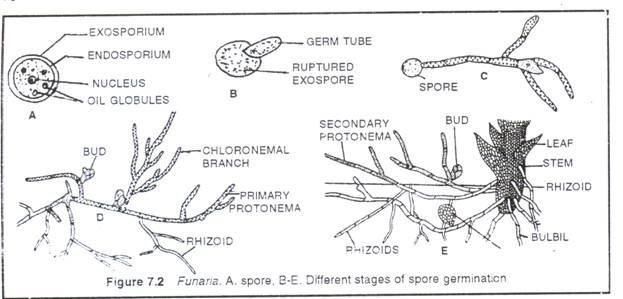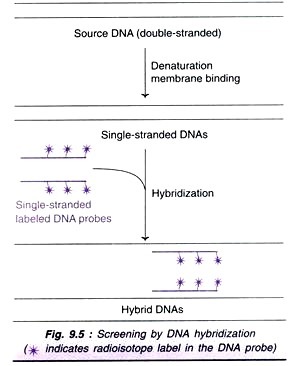ADVERTISEMENTS:
Read this article to learn about the Life Cycle of Funaria: Sexual and Vegetative Life Cycle !
Systematic positions:
Kingdom : Plantae
ADVERTISEMENTS:
Class : Musci
Family : Funariaceae
Species : hygrometrica
Division : Bryophyta
ADVERTISEMENTS:
Order : Funariales
Genus : Funariales
Plantae : Musci
Habit and Habitat:
The genus Funaria includes about 117 species which are cosmopolitan in nature. They are the common moss, also known as cord moss or green moss. It forms velvety tufts on moist ground, rocks, tree trunks, under shade etc. About 15 species of Funaria have been reported from India. Funaria hygrometrica is a common moss on Indian hills.
Life cycle of Funaria:
In Funaria, two types of life cycle seen: Sexual and vegetative.
A. Sexual life cycle:
The life cycle of Funaria is haplo-diplontic type. In the life cycle free living haploid gametophyte alternates with a semiparastitic diploid sporogonium (Sporophyte). In this type alternation of generations is called heteromorphic or heterologous. In Funaria the main plant body is free-living gametophyte (n) which exist in 2 forms i.e. protonema (juvenile gametophyte) and leafy gametophore (adult gametophyte).
ADVERTISEMENTS:
1. Spore germination and Protonema:
Spore is the first cell of gametophytic generation. On a suitable damp habitat, a meiospore of Funaria germinates into a filamentous green alga-like structure called protonema. Protonema has green epiterranean chloronemal branches (chlornema) and non-green subterranean rhizoidal branches (caulonema). Chloronemal branches produce several buds, each of which develop into a leafy gametophore.
2. Adult Gametophore:
It is a long 1-3 cm in height and differentiated into rhizoids, axis (stem) and leaves.
ADVERTISEMENTS:
i. Rhizoids:
Multicellular, colourless root-like structures with oblique septa. They help in anchorage and absorption.
ii. Axis:
It is 1-3 cm in height and branched. The axis and its branches covered with spirally arranged leaves. While the tip of axis contain crowded young leases forming a bud like structure. The growth of the axis is due to the activity of a pyramidal apical cell.
ADVERTISEMENTS:
iii. Leaves:
Leaves are sessile, ovate and green. Each leaf has a mid rib, on both side of which single layered wing present.  3. Sex organs:
3. Sex organs:
Adult gametophore is monoecious and autoecious i.e. male and female sex organs develop at the tips of separate shoots of the same gametophore.Antheridia (Male sex organs)-The main axis is called male shoot or antheridiophore. The tip of male shoot has a convex disc or receptacle on which a cluster of club-shaped antheridia intermingled with like capitates paraphysis arises.
The receptacle is surrounded by rosette of perigonial leaves. Each mature antheridium has a short talk and a dub-shaped jacketed body. Inside the jacket, a mass of androcyte mother cells present, each of which diagonally divides into two androcytes. Each androcyte develops into a biflagellate antherozoid. Archegonia (Female sex organs):
Archegonia (Female sex organs):
The female shoot arise from the base of the male shoot and called as archegonial branch or archegoniophore. The apex of fem ale shoot is called female receptacle from which cluster of archegonia arise intermixed with non- capitate paraphysis. Further, the female receptacle is surrounded by perichaetial leaves (perichaetium). Each archegonium has a stalk, flask-shaped venter and a neck. Venter encloses a basal egg cell (oosphere) and upper smaller venter canal cell. Neck consists of 6 or more neck canal cells (6-11).
ADVERTISEMENTS:
4. Dehiscence of sex organs:
When the surface of moss plant is wet, the mature antheridia absorb water and burst releasing the male gametes (antherozoids). The male gametes swim towards archegonia. In each mature archegonium, neck canal cell and venter canal cells degenerate to form mucilage. The mucilage swells up and opens the tip to create a passage up to egg. The mucilage contains sucrose which attracts the male gametes (chemotactic).
5. Fertilization:
Funaria is protandrous i.e. male sex organs mature first. Hence, Cross-fertilization takes place. Water is essential for fertilization. During heavy rains, the antherozoids reach the vicinity of archegonial neck and swim down to venter. Any one antherozoid fuses with egg to form zygote (2n). Soon, the zygote secretes a cell wall and becomes the oospore. The oospore divides and redivides to form embryo. Later the embryo grows into a sporophyte or sporogonium. Thus, zygote or oospore is the first cell of sporophyte generation.
The sporogonium of Funaria is photosynthetic, hence semi-parasitic on gametophore. It differentiates into foot, seta and capsule. The foot embedded in the female receptacle and absorbs inorganic nutrients. Seta is a long stalk with a pear-shaped capsule by its tip. Capsule has 3 parts-basal apophysis, central theca and terminal operculum.
Annulus is ring like cell separates operculum and Theca. The middle fertile theca, from centre to outside, consists of a sterile columella, surrounded by a barrel-shaped spore sac, a cylindrical air space with trabeculae, hypodermis and epidermis. As the sporogonium grows, the venter grows along with it in the form of a protective covering called calytra. Later the calyptra ruptures and remains like a cap on the capsule. Calyptrais haploid because it develop from venter wall. 
7. Dehiscence of capsule and dispersal of spores:
When the capsule dries up, Operculum thrown off to expose the peristome consisting of two overlapping rings of periostomial teeth. Each ring of peristome possesses 16 teeth. The teeth of outer ring (exostome) are conspicuous, red with thick transverse bands whereas the inner rings (endostome) are comparatively small, colourless and soft. The dispersal of spores is due to hygroscopic movements (viz. movement due to moisture contents of atmosphere) of exostome of peristomial teeth. The inner ring of peristomial teeth do not show hygroscopic movement.
B. Vegetative cycle:
In Funaria, the alternation of generations is not always obligatory. Frequently, the gametophyte undergoes vegetative propagation to form a succession of the gametophyte generations before the sporophyte generation develops.
ADVERTISEMENTS:
Vegetative propagation is a method by which a part of the gametophyte separate or specialized to form a new individual.
The various methods of vegetative propagation in Funaria are:
(a) By fragmentation of Primary protonema:
Accidentally, or death of intercalary, segment sometime causes fragmentation of primary protonema, each fragment can give rise to leafy gametophore.
(b) By secondary protonema:
Secondary protonema develops from any cell of injured part of gametophore. This develops lateral bud which grows into leafy gametophore.
(c) By Bulbils (tubers):
These are perinnating structures developed on rhizoids. On return of suitable condition, each of them produces a protonema.
(d) By Gemmae:
The apices of protonemal branches, leaves an axis develop gemmae. Detached gammae give rise to gametophore under favourable condition.
(e) Apospory:
This is the vegetative propagation of sporogonia in which any somatic cell produce leafy gametophore without spore formation. The aposporously produced gametophores are exceptionally diploid (2n).



